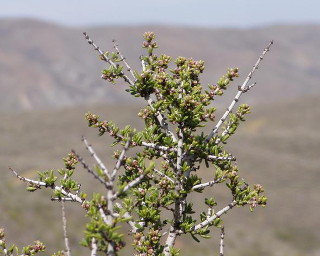(Ceanothus ophiochilus)
 Ceanothus ophiochilus. Photo © Brian Parker.
Ceanothus ophiochilus. Photo © Brian Parker.
Vail Lake ceanothus is a California endangered species, which means that killing or possessing the plant is prohibited by the California Endangered Species Act (CESA). The species is also listed as threatened under the federal Endangered Species Act. Vail Lake ceanothus is a perennial evergreen shrub that blooms in March and April. At the time of this webpage posting, the California Natural Diversity Database contains three occurrences of Vail Lake ceanothus, all within Riverside County. One occurrence is located west of Vail Lake on private property and two occurrences are located approximately three miles to the south and largely within the Agua Tibia Wilderness, although a portion of one of these is also on private property. The species is found in chaparral communities and is restricted to specific soils. Vail Lake ceanothus has been found on patches of gabbro and pyroxenite-rich outcrops at the Vail Lake occurrence, and within a mix of gabbro and sedimentary deposits at the Agua Tibia Wilderness occurrences.
Although the U.S. Forest Service has implemented protective measures within the two Agua Tibia Wilderness occurrences, fire fuels management activities and altered fire regimes represent the primary threats to all three Vail Lake ceanothus occurrences. Urban development and related activities could also impact the 31 percent of currently mapped Vail Lake ceanothus habitat which occurs on private land. Climate change is also considered to be a threat to Vail Lake ceanothus due to predicted changes in temperature conditions and an increase in fire risk. In addition, impacts from fires, fire fuels management, development, and climate change could all increase the risk to Vail Lake ceanothus from invasive plant species. The loss of genetic identity and viability through hybridization could also threaten Vail Lake ceanothus.
Cooperation with landowners is needed to help prevent the extinction of Vail Lake ceanothus. Populations of the species on private land should be conserved or preserved if possible, particularly at the Vail Lake occurrence. Populations of Vail Lake ceanothus should also be monitored, and information on abundance, habitat conditions, and potential threats should be collected. Research investigating the impact and extent of Vail Lake ceanothus hybridization should also be conducted.
CDFW may issue permits for Vail Lake ceanothus pursuant to CESA, and you can learn more about the California laws protecting Vail Lake ceanothus and other California native plants. Populations of Vail Lake ceanothus occur in CDFW’s Inland Deserts Region. More information is also available from the U.S. Fish and Wildlife Service Species Profile for U.S. Fish and Wildlife Service Species Profile for Ceanothus ophiochilus.
Updated 9/23/2013